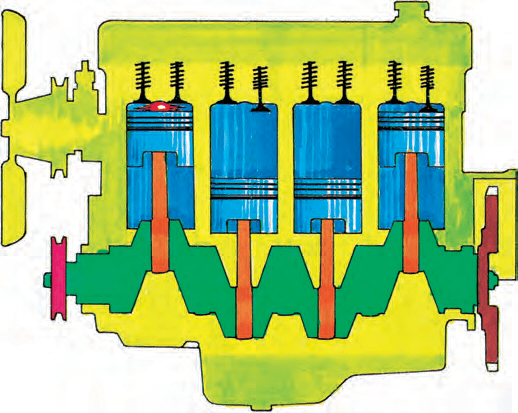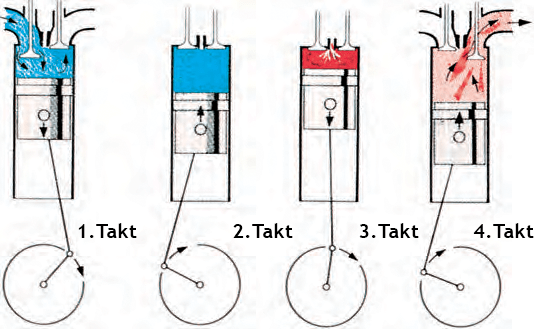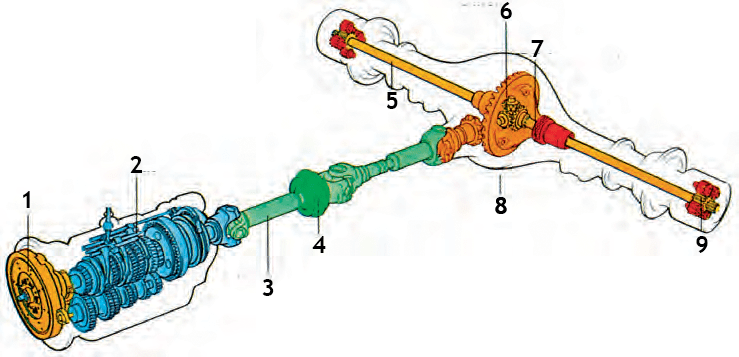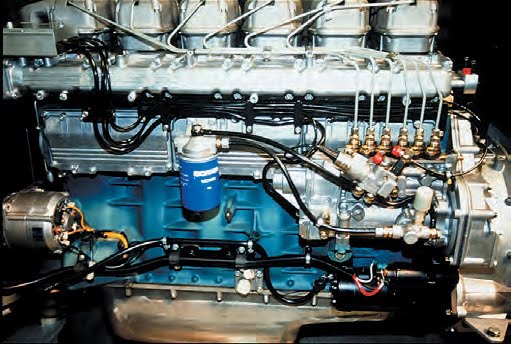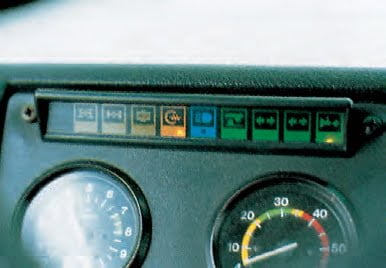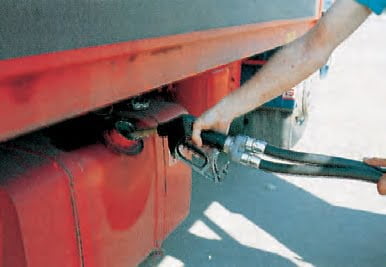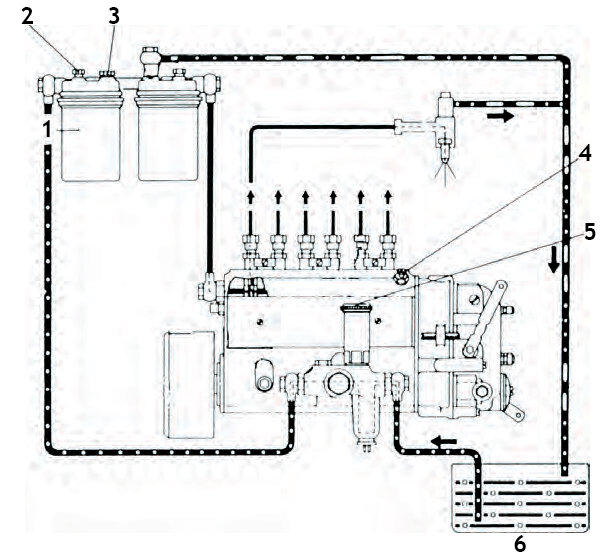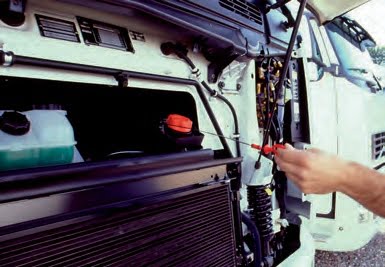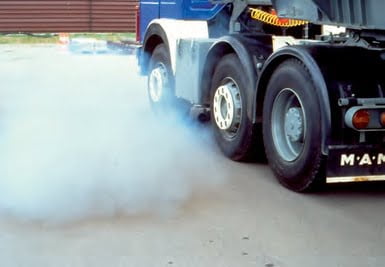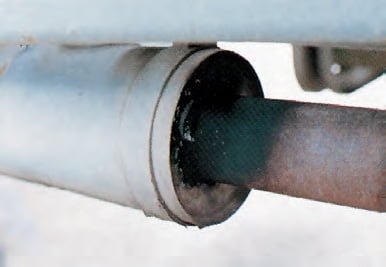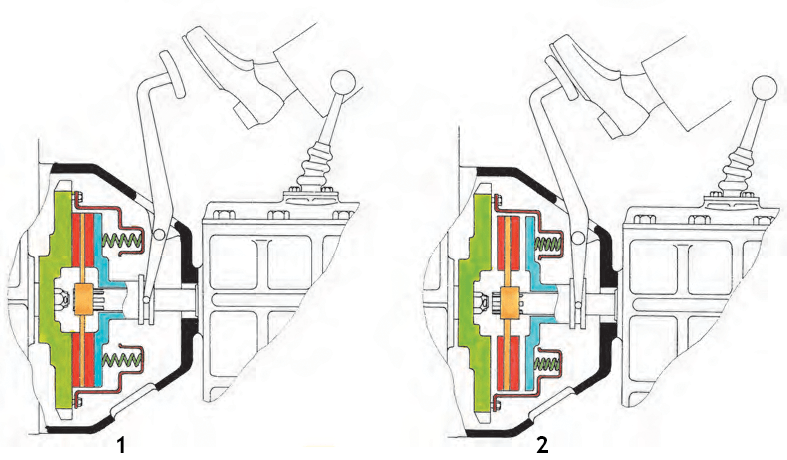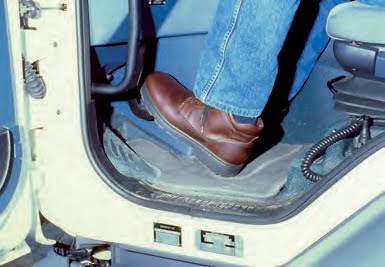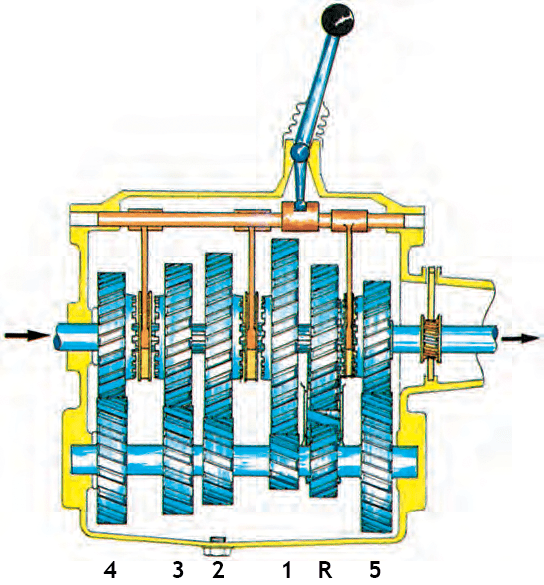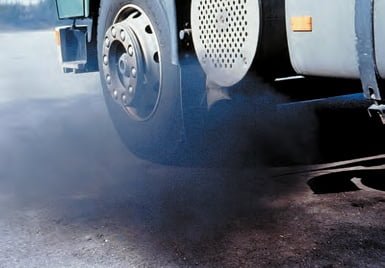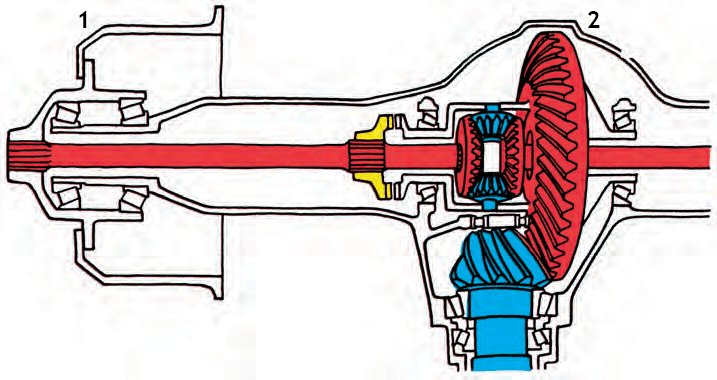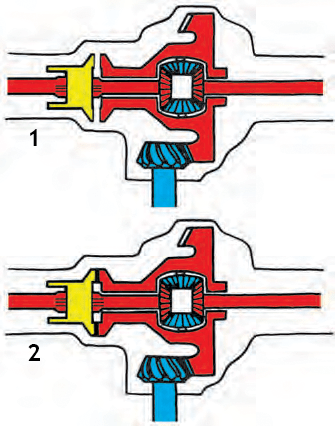large cars
Driving school
theory book
for category C - D - C/E - D/E
Large cars and lorries
6. Engine and transmission.
Engines
The car's engine can be either petrol or diesel. The engine in lorries and buses is in most cases a 4-stroke diesel engine with 6, 8 or more cylinders.
4-stroke engine:
The principle of the 4-stroke engine is that a piston in each of the engine's cylinders is set in motion when a mixture of air and fuel is ignited.
The movement takes place in four beats:
1. suction
2. Compression
3. Combustion
4. Exhaust
The up and down motion of the pistons is translated into rotational motion by a crankshaft, and this motion is passed through the clutch, gearbox and differential to the car's drive wheels.
Diesel engines
In a diesel engine, air is sucked into the cylinder and the fuel is injected into the cylinders under high pressure using nozzles. In front of the air intake is an air filter to retain impurities in the air. In front of the fuel pump is a fuel filter to retain impurities in the fuel. These filters must be replaced at regular intervals.
In a diesel engine, combustion occurs by spontaneous combustion due to the high pressure in the cylinder (compression). Auto-ignition requires high temperature/pressure. Therefore, when starting the engine, the air in the cylinders often needs to be heated.
This is often done using a glow plug that is energised by a switch on the dashboard or by operating the ignition key.
1. coupling.
2. Gearbox.
3. Cardan shaft.
4. Support bearing.
5. Drive shaft.
6. Differentials.
7. Differential lock.
8. Baking utensils.
9. Hub reduction.
Diesel engines.
Fuel pump.
Fuel filter.
Speed limiter.
Nozzle pipe.
Operating errors:
- If the preheater is not used or is used too briefly, a cold diesel engine may not start or start only with difficulty.
- If the wrong fuel is selected during the winter period, there is a risk of engine failure due to blockage (paraffin formation) in the fuel filter or in the fuel pipe between the tank and the engine.
Venting the fuel system:
Air in the fuel system will cause starting difficulties and subsequent loss of traction or engine stalling.
Venting the fuel system may be necessary in the following cases:
- The fuel system has been faulty, allowing air to enter.
- The car has run out of fuel.
- The fuel system has been opened for cleaning or changing filters.
- The engine has been idle for a very long time.
Ventilate according to the instructions in the user manual.
1. fuel filter.
2. Vent screw.
3. filling screw.
4. venting screw.
5. Hand pump.
6. Fuel tank.
Checking the engine:
- It is important that the engine is filled with sufficient lubricating oil. The oil level must be between the minimum and maximum marks on the dipstick (check light, if applicable).
- The cooling system must be sufficiently filled according to the instructions in the user manual.
- For cars that include hydraulics for the clutch, check the system for sufficient fluid.
- The exhaust system must be tight and have sufficient noise dampening effect, as judged by abnormal exhaust noise.
Signs of engine failure:
- Excessive smoke from the engine exhaust can indicate a worn engine or a fault in the fuel system.
- If there is an abnormal amount of noise when accelerating, this indicates a fault in the exhaust system (breakage or corrosion).
Speed limiter:
- Newer trucks must be equipped with a speed limiter set so that the speed cannot exceed 90 km/h.
- Newer buses and coaches must be equipped with a speed limiter set to a maximum of 100 km/h.
Lubrication
- Lubrication, antifreeze and maintenance should be carried out according to the vehicle manufacturer's instructions. See the instruction manual.
The main function of the clutch is to engage and disengage the connection between the engine and gearbox at standstill and during gear changes. The clutch must be able to transmit the full traction of the engine without slipping when engaging the clutch.
The clutch is usually activated by pedal pressure, which is often transferred to the clutch using hydraulics and possibly compressed air. This means that it can be very difficult to activate the clutch without compressed air from the vehicle's compressed air system.
Signs of failure:
If the engine revs increase when accelerating without increasing the car's speed, this indicates a fault in the clutch, i.e. the clutch is "slipping".
(Gear selection is difficult to listen to due to the design and positioning of the engine. You should therefore follow the instructions in the car's owner's manual).
If gear shifting is difficult with loud noises, it could indicate a malfunction or a fault in the gearbox or clutch.
In order to make the necessary adjustments to speed and traction, the car must be equipped with a gearbox that contains a number of gear sets that can be used in different combinations. Most large cars have five or more gears for forwards and one gear for reverse. On larger cars, there is a switch between "High" and "Low" gears, which allows for more choice in selecting the appropriate gear. To operate such a gear, follow the instructions in your car's owner's manual. For certain driving styles, fully automatic gearboxes are used.
Operating errors:
Driving in the wrong gear, which overloads and damages the engine, can lead to unnecessary smoke development.
Differentials
The differential basically consists of a gear mechanism inserted between the axles of the car's drive wheels. The differential is connected to the gearbox through a cardan shaft and is designed so that the engine's traction is distributed equally to both rear wheels while allowing the rear wheels to rotate at different speeds, which is necessary when cornering.
Differential lock
With a differential lock, the effect of the differential can be cancelled so that the rear wheels can only rotate at the same speed. This prevents wheel spin where the rear wheels have different traction, e.g. in slippery or greasy conditions. The differential lock can be switched on and off using a switch on the instrument panel, either when the car is stationary or during straight-ahead driving, where both rear wheels have equal grip and rotate at the same speed.
Operating errors:
- Cornering with the differential lock engaged carries a high risk of damaging the differential and significantly alters the driving behaviour (steering).
1. Differential lock disengaged.
2. Differential lock engaged.
ASR (Anti Spin Regulation)
ASR prevents the drive wheels from spinning (spinning), e.g. on a slippery road surface, when exiting snowed-in stops or when cornering on a greasy road surface. ASR regulates for optimal propulsion. A warning light alerts the driver if the ASR system is in operation.
Energy and environmentally friendly driving
To avoid air and noise pollution, do not let the engine idle for long periods of time. The engine should only be started just before driving or for the short time necessary to achieve sufficient working pressure in the brake system. The driving style also has a significant impact on fuel consumption. High speeds and aggressive driving with strong acceleration, for example when overtaking, significantly increase fuel consumption, while proper driving technique can save up to 10% of fuel. Energy-efficient driving technique means generally avoiding unnecessary and frequent speed changes.
Other legal provisions on eco-driving
- The vehicle must be operated in such a way that it does not produce unnecessary noise, fumes and gases.
- Unnecessary and disruptive driving must not take place in built-up areas. If driving is necessary, the driver must drive in such a way that others are disturbed as little as possible.
- Any bans on idling.
- When slowing down, fuel consumption can be reduced by fully releasing the accelerator and applying the engine brake (engine braking) rather than disengaging.
Test your knowledge
Cat. C - D - C/E - D/E - D/E - Section 6
Select the questions you think are the right ones.
